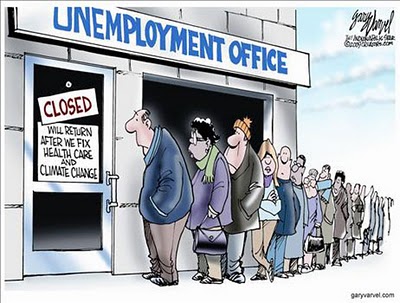Oct. 26, 2010
Nov. 10, 2014 Repaired broken links

Depth of Unemployment Far Worse Than the Data Suggests
original article written by Net Advisor™
CBS TV weekly news program, 60 Minutes discussed some of the unemployment issues that have been plaguing the economy, and the Obama Administration.
Beginning last February 17, 2010, I discussed in detail frequently citing the government’s own official records how the Obama Administration has been misleading the American public about the jobs numbers (Report).
On March 5, 2010, and on June 5, 2010, I continued to argue this point and how the jobs data is being misrepresented and manipulated arguably for political gain; this is an election year.
Seven months later after this first report, one of the first major media organizations, CBS openly discusses at least the real job loss numbers. CBS did not report about the job numbers being manipulated per se, but their report shows a stark contrast to the government’s data and supports the three arguments about the manipulation of the jobs data.
The Obama Administration’s position has been that the national unemployment rate in the U.S. is about 9.5% (nine-and-a-half-percent), still high by historical standards (Source: U.S. Bureau of Labor Statistics (BLS), Page 1 of 39 Page Report, PDF).
Unemployment Rate – Chart
Note the year-over year, 2009 to 2010 unemployment rates. Red bold text shows where unemployment is 10% or higher.
| Unemployment Rate | 2009 Rate* | 2010 Rate** |
|---|---|---|
| Michigan | 9.6% | 13% |
| Rhode Island | 9.3% | 11.5% |
| California | 8.4% | 12.4% |
| South Carolina | 8.4% | 11% |
| Oregon | 8.1% | 10.6% |
| District of Columbia (Washington, DC) | 8% | 9.8% |
| Nevada | 8% | 9.8% |
| North Carolina | 7.9% | 9.6% |
| Georgia | 7.5% | 10% |
| Alaska | 7.3% | 7.8% |
| Florida | 7.3% | 11.9% |
| Illinois | 7.3% | 9.9% |
| Ohio | 7.3% | 10% |
| Mississippi | 7.2% | 9.8% |
| Indiana | 7.1% | 10.1% |
| Kentucky | 7% | 10.1% |
| Tennessee | 6.9% | 9.4% |
| Missouri | 6.7% | 9.3% |
| Connecticut | 6.6% | 9.1% |
| Minnesota | 6.4% | 7% |
| Washington (state) | 6.4% | 9% |
| Arizona | 6.3% | 9.7% |
| Maine | 6.3% | 7.7% |
| Alabama | 6.1% | 8.9% |
| New Jersey | 6.1% | 9.4% |
| New York | 6.1% | 8.3% |
| Pennsylvania | 6.1% | 9% |
| Massachusetts | 5.9% | 8.4% |
| Colorado | 5.8% | 8.2% |
| Arkansas | 5.7% | 7.7% |
| Idaho | 5.7% | 9.0% |
| Texas | 5.7% | 8.1% |
| Vermont | 5.7% | 5.8% |
| Delaware | 5.6% | 8.4% |
| Wisconsin | 5.6% | 7.8% |
| Louisiana | 5.3% | 7.8% |
| Maryland | 5.3% | 7.5% |
| Hawaii | 4.9% | 6.3% |
| Kansas | 4.9% | 6.6% |
| Montana | 4.9% | 7.4% |
| Virginia | 4.8% | 6.8% |
| Oklahoma | 4.7% | 6.9% |
| West Virginia | 4.6% | 9.2% |
| Iowa | 4.3% | 6.8% |
| New Hampshire | 4.3% | 5.5% |
| New Mexico | 4.3% | 8.2% |
| Nebraska | 3.7% | 4.6% |
| Utah | 3.7% | 7.5% |
| South Dakota | 3.4% | 4.4% |
| North Dakota | 3.3% | 3.7% |
| Wyoming | 3.2% | 6.8% |
| Puerto Rico (U.S. Territory) | n/a (CNN) | 16.3% |
[Chart Data Sources: *CNN (HTML version); CNN (PDF print version) data as of 10-21-2009; **Bureau of Labor Statistics (BLS.gov) P10 of 19, Table 3, Seasonally Adjusted, data as of 10-22-2010.]
There seems to be some discrepancy in the chart either by CNN or the BLS. This could account for whether the data is seasonally adjusted. The BLS shows lower a unemployment rate than CNN reported in 2009 (chart above). The BLS also shows a higher unemployment rate in 2009 than CNN.
If we use CNN’s numbers the unemployment rate has gone up in 2010 from 2009 levels. If we use the BLS data, unemployment in some states shows it has gone down slightly in 2010 from 2009.
Keep in mind that the government does not count all people who are truly unemployed (Report). So, not sure who’s data we should rely on, only that I have demonstrated that the government data (BLS) to be misleading.
If you then take the CBS 60 Minuets 10-24-2010 report, a fourth opinion on the unemployment numbers; (the other three being the BLS.gov, CNN, and NetAdvisor.org), then examine the unemployment numbers, they tend to support CNN and NetAdvisor.org’s analysis. The result of this would suggest that the unemployment rate is far higher than the Obama Administration is willing to acknowledge.
To give consideration to the BLS’s unemployment calculation, they state in their 10-22-2010 report that the unemployment numbers for this period (shown in chart above, right column) are “seasonally adjusted” and “preliminary,” and thus subject to revision.
However if one tracks the BLS data, the tendency has been to embellish the jobs data upon media release, then the following month revise the jobs numbers downward. The political motive is to grab headlines by the national media that the economy and jobs market is improving. A month later no one broadcasts with the same amount of time and energy that the previous months data was not exactly accurate, and has subsequently been revised downward.
We saw a major “discrepancy” that may have thrown off the October 2010 unemployment numbers reflecting back to the same period in 2009. The Labor Department acknowledged that they overstated the unemployment data from about March 2009 to March 2010.
“The Labor Department on Friday will give an initial estimate of how far off its count of employment may have been in the 12 months through March. The government admitted earlier this year that its count through March 2009 had overstated employment by 902,000 jobs.”
— Source: Reuters, 10-07-2010 (underline added to note emphasis).
The Labor Department of course came up with some technical excuse of how the Obama Administration said it created 902,000 jobs when in fact this was false data (Source: Reuters).

As a result of reporting overstating the unemployment numbers in this said period, the 2010 numbers will look better than 2009, however 2009 numbers will look a lot worse that we were actually told. The only problem with this October 7, 2010 news release is that the period covers only through March. It does not cover through September, thus even with the government’s admission of reporting inaccurate jobs data, it still does not explain CBS’s report (text and video below) that suggest the unemployment rate is significantly higher than government’s unemployment calculations.
“The national unemployment rate of about nine and a half percent sounds incredibly high and of course it is. But it doesn’t nearly capture the depth of the trouble. It doesn’t count the people who’ve seen their hours cut to part time. It doesn’t count the people who have quit looking for work.
If you add all of that together, the unemployed and the underemployed, it’s not nine and a half percent (9.5%), it’s 17 percent (17%); and in California it’s 22 percent (22%).”
— Source: CBS 60 Minuets, 10-24-2010
One day after CBS 60 Minuets aired this report, the President Obama was found campaigning in Rode Island touting his Administration’s job-creation efforts. The president also acknowledged that ‘some of his policies were not popular.’ (Source: Reuters). Unpopular political policies and poor unemployment numbers won’t play well in the November election, and if such continues which I believe the economy will lag for many more years to come, this may also play out in the 2012 Presidential Election.
Watch the full video:
Video: 99 Weeks: When Unemployment Benefits Run Out
Produced by Robert Anderson, Daniel Ruetenik, and Nicole Young
Reported by Scott Pelley
If unable to view 60 Minuets Video (above), here is the direct link. Adobe Flash player plug-in may be required for video viewing. Story: text only version.
Second Video Link from YouTube.
__________________________________________________________________________
short link to this article: https://www.netadvisor.org/?p=5766
Images/graphics copyright by their respective owners.
Video courtesy of CBS Interactive Inc., Copyright CBS Interactive Inc.
Original content copyright © 2010, 2014 NetAdvisor.org® All Rights Reserved.
NetAdvisor.org® is a non-profit organization providing public education and analysis primarily on the U.S. financial markets, personal finance and analysis with a transparent look into U.S. public policy. We also perform and report on financial investigations to help protect the public interest. Read More.
__________________________________________________________________________

